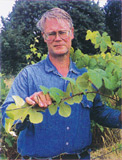Grapes In Florida
By Lon J. Rombough
Author and grape grower Lon Rombough, whose
new book, The Grape Grower was reviewed
in a previous issue, has written a column aimed at the difficult growing
conditions of Florida, USA. Much of the information can be applied to any
planting in similar climates. (If you visit the review we suggest you use
your browser's back button to return to this issue).
Florida has cool winters, sometimes punctuated by cold blasts, while
some locations have freezes, others may have only a light frost. A few
areas may skip a year or more of damaging cold. Winter is dry, but, once
the rains start the climate can be much like steaming a lobster – hot, humid
– ideal for disease.
 What grape varieties can I grow in the tropics?
What grape varieties can I grow in the tropics?
We've seen that the major
limiting factor in choosing grape varieties for a tropical area is usually
disease, especially Pierce's disease. In Florida, bunch grape varieties
bred to tolerate disease include ones like Stover, Conquistador, Lake
Emerald, Blanc Du Bois, and many others. Most of these use at least
one selection in the parentage that comes from more northerly areas, at
least partly for the flavor of them. Concord, from Massachusetts,
being the grape everyone knows, shows up in the background of several
Florida grapes. Golden Muscat, in the parentage of Lake Emerald, comes
from the Cornell University breeding program at Geneva, New York. The
important part is the other parent, which has to pass the needed disease
resistance to it's offspring.
For home use, the best advice I can give Floridians
is to buy from local nurseries. Not the "big box" stores, but actual
nurseries. A search for "Florida grape nurseries" on the internet
will turn up about as many as you are ever apt to need. They will list varieties
such as the ones mentioned, as well as others like "Miss Blue" and "Miss
Blanc". These grapes were bred in Mississippi for near-coastal conditions
and will adapt well to Florida. Note that not all are completely
resistant to disease, but all will tolerate Pierce's Disease, the one that
can't be treated with fungicides. Other diseases may affect them to varying
degrees, but those can be controlled with things like spray.
One other group of grapes well worth trying are
varieties bred by T.V. Munson in the late 1800's and early 1900's. He
used American species in the parentage of his varieties that were highly resistant
to disease, and he did his work in Denison, Texas, which is an area that
is still within the realm of Pierce's Disease. As a result, some of
his varieties have very good resistance to PD, and other diseases, and are
worth trying in tropical, disease-prone areas. Some that have succeeded
include Lomanto, Carmen, Champanel, and America. Many others are worth
trying. You can read about his varieties in his book "Foundations of
American Grape Culture." Though the book was published in 1926, it
is available both as a reprinted version, and it can also be read online.
Put the name of the book into a search engine and you'll find it quickly.
In other tropical areas, where PD is not a problem,
even Vitis vinifera can be grown. In fact, wine is now being produced
commercially in countries such as India, using varieties like Chardonnay,
Sauvignon Blanc, and others. In fully tropical climates, where disease isn't
a major problem, the main issue is dormancy of the vine. Grapes require
dormancy to get them to grow and bear. Without it, some vines will
"adapt" by continuing to grow, bloom, and set fruit continually. However,
in this situation, the amount of fruit that is ripe at any one time isn't
commercially useful, and the vines soon become unmanageable when allowed
to grow continually. As a result, it is necessary to put the vine through
a period of enforced dormancy. The basic procedure is fairly simple.
After harvest, water and nutrients are withheld
from the vine to slow it's growth, and the vine is manually defoliated. Leaves
may be stripped by hand, or sprayed with a chemical such as urea to burn
them and make them drop. In the tropics, this is usually done
at a time when a dry period is underway. The vine is left in this
condition until time for it to start growing again. Then it is pruned
much the same way as a truly dormant vine would be, and it is fertilized
and watered. This will force the vine to resume growth, bloom, and
set fruit. Properly timed, it is possible to get two crops a year from
a vine this way.
The major problem with this method is that new
growth tends to come only from buds near the ends of the vine. This
means that after a few years, most growth is out at the ends of the vine
and the center area is "bald" or without growth. Because of this, the vines
eventually become unmanageable. The usual solution is to cut the vine
off and force new shoots that can be trained up as a new vine, starting the
cycle over.
Next time we'll cover what the future holds for
growing grapes in the tropics.
© MMIV - Volume 1 Number 5 Whole Number 5 Tropical Visions September 2004
 What grape varieties can I grow in the tropics?
What grape varieties can I grow in the tropics?  What grape varieties can I grow in the tropics?
What grape varieties can I grow in the tropics?